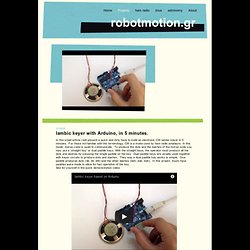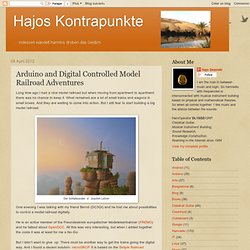

Robotmotion.gr. In this small article I will present a quick and dirty hack to build an electronic CW iambic keyer in 5 minutes.

For those not familiar with the terminology, CW is a mode used by ham radio amateurs. In this mode, morse code is used to communicate. To produce the dots and the dashes of the morse code you may use a ‘straight key’ or dual paddle keys. With the straight keys, the operator must produce all the dots and dashes by pressing the single paddle on the key. Dual paddle keys are usually used together with keyer circuits to produce dots and dashes. See for yourself in the quick demonstration video. The keyer presented here is a generic circuit that can be used with any homebrew transceiver to operate in CW mode, for practicing the code etc. You will need the following parts 1x Arduino board. 1x 8 Ohm speaker for listening to the circuit’s output 2x fast-on pins for PCB 1x small 15x20mm piece of prototyping PCB 2x 470K resistors .SMD or through-hole.
#define DIT_PIN 8 #define DAH_PIN 10. Open source arduino CW keyer with memory. Arduino SimpleSat Rotor Controller. The Arduino series of boards is an excellent choice for a satellite rotor controller.

This controller uses the Yaesu GS-232 command set to control a Yaesu G-5500 Az-El rotor. The controller was designed to be compatible with the SatPC32 tracking program and should work with any tracking program that supports the Yaesu GS-232 format. This controller has been tested with the Arduino UNO and the Arduino Mega2560. Below is a picture of the Arduino Mega2560 board. The board has a USB interface and is capable of being powered from the USB port or an external power supply. AdruinoRC-1 The Arduino series of boards are set up for plug in daughter boards (shields). Arduino automatic CQ caller for amateur radio. Www.sbara.org/presentations/Antenna_Positioning_System_with_Arduino_K6VUG.pdf. Robotmotion.gr. Arduino, IR and Encoder controlling Magnetic Loop Antenna Tuner. K3NG Arduino CW Keyer - Browse Files. Arduino CW Keyer. Updated 2014-03-03 This is an open source Arduino based CW (Morse Code) keyer with a lot of features and flexibility, often rivaling commercial keyers.

The code can be used with a full blown Arduino board or an AVR microcontroller chip can be programmed and used directly in a circuit. This keyer is suitable as a standalone keyer or for use permanently installed inside a rig, especially homebrew QRP rigs. It’s open source code so you can fully customize it to fit your needs and also perhaps learn from it or find coding ideas for other projects. A circuit board and parts kits called the nanoKeyer is available from DJ0MY, and Hamshop offers a kit called Open CW Keyer which uses this software. Features Basic Schematic (Click to Enlarge) Note: Ignore the numbers on the outside of the Arduino symbol and refer to the numbers within the box for pin connections (i.e. Another circuit schematic featuring optoisolated outputs and a speed rotary encoder (PDF) Connecting the Keyer Command Buttons \? Weekend Projects – Hot/Cold LEDs. 30 Arduino Projects for the Evil Genius. Arduino EMF detector.
The Marketplace for Makers. Morse En-/De-coder (Arduino Morse encoder / decoder) Two Ways to Measure Temperature: Analog Dialogue: Analog Devices. Volume 44 – October 2010 Download this article in PDF format. (656KB) Two Ways to Measure Temperature Using Thermocouples Feature Simplicity, Accuracy, and Flexibility By Matthew Duff and Joseph Towey Introduction The thermocouple is a simple, widely used component for measuring temperature.

This article provides a basic overview of thermocouples, describes common challenges encountered when designing with them, and suggests two signal conditioning solutions. Thermocouple Theory A thermocouple, shown in Figure 1, consists of two wires of dissimilar metals joined together at one end, called the measurement ("hot") junction. Figure 1.
*We use the terms "measurement junction" and "reference junction" rather than the more traditional "hot junction" and "cold junction. " Arduino and Digital Controlled Model Railroad Adventures. Long time ago I had a nice model railroad but when moving from apartment to apartment there was no chance to keep it.

What remained are a lot of small trains and wagons in small boxes. And they are waiting to come into action. But I still fear to start building a big model railroad. One evening I was talking with my friend Bernd (DC3QI) and he told me about possibilities to control a model railroad digitally. He is an active member of the Freundeskreis europäischer Modeleisenbahner (FREMO) and he talked about OpenDCC. But I didn't want to give up.